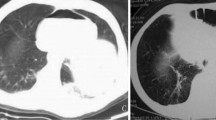Abstract
Purpose
The most common cardiac injuries in the United States are blunt trauma from motor vehicle accidents or low-velocity trauma from stabbings. During military conflict, high-velocity injuries, including gunshot wounds (GSW) and fragment injury from improvised explosive devices (IED), are relatively more common.
Methods
This is a retrospective review of cases with high-velocity penetrating injury and suspected myocardial involvement during a 6-month period in Baghdad, Iraq, at a United States Army hospital during Operation Iraqi Freedom.
Results
Eleven cases survived to admission (GSW in 5, IED in 6). The mean age of the all-male cohort was 27 years (range, 3–54 years). Eight of the 11 patients (73%) were victims of polytrauma. The entrance involved the right ventricle (n = 3), right atrium (n = 2), left ventricle (n = 1), or mediastinum and pericardial reflections (n = 5). Echocardiography was performed in all 11 patients. In 7 patients, no foreign body was identifiable, and in 2 patients the foreign body was identified within the pericardial fat pad. Three patients were identified as having a suspected ventricular septal defect, ranging in size from 2 to 8 mm. The most common electrocardiographic abnormality was atrioventricular block and right bundle branch block. In 4 patients, the management of the chest injury was nonsurgical, and in 1 patient the treatment was a chest tube only. Four of the patients underwent median sternotomy, 1 underwent emergent lateral thoracotomy, and 1 underwent an infradiaphragmatic approach.
Conclusion
This case series is too small to draw definitive conclusions; however, a multidisciplinary approach to high-velocity injuries with potential for cardiac involvement augments preoperative assessment for myocardial injury and may allow selective nonoperative management.
Similar content being viewed by others
References
Homer, Lattimore RA. The Iliad. Chicago: University of Chicago Press; 1961.
Asensio JA, Stewart BM, Murray J, Fox AH, Falabella A, Gomez H, et al. Penetrating cardiac injuries. Surg Clin N Am 1996;76(4):685–724.
Sugg WL, Rea WJ, Ecker RR, Webb WR, Rose EF, Shaw RR. Penetrating wounds of the heart: an analysis of 459 cases. J Thorac Cardiovasc Surg 1968;56(4):531–545.
Blalock A, Ravitch M. A consideration of the nonoperative treatment of cardiac tamponade resulting from wounds of the heart. Surgery (St. Louis) 1943;14:157.
Campbell NC, Thomson SR, Muckart DJ, Meumann CM, Van Middelkoop I, Botha JB. Review of 1198 cases of penetrating cardiac trauma. Br J Surg 1997;84(12):1737–1740.
Asensio JA, Berne JD, Demetriades D, Chan L, Murray J, Falabella A, et al. One hundred five penetrating cardiac injuries: a 2-year prospective evaluation. J Trauma 1998;44(6):1073–1082.
Tyburski JG, Astra L, Wilson RF, Dente C, Steffes C. Factors affecting prognosis with penetrating wounds of the heart. J Trauma 2000;48(4):587–590.
Embrey R. Cardiac trauma. Thorac Surg Clin 2007;17(1):87–93, vii.
Scalea TM, Rodriguez A, Chiu WC, Brenneman FD, Fallon WF Jr, Kato K, et al. Focused assessment with sonography for trauma (FAST): results from an international consensus conference. J Trauma 1999;46:466–472.
Rozycki GS, Shackford SR. Ultrasound, what every trauma surgeon should know. J Trauma 1996;40:1–4.
Plummer D, Brunette D, Asinger R, Ruiz E. Emergency department echocardiography improves outcome in penetrating cardiac injury. Ann Emerg Med 1992;21:709–712.
Hanpeter DE, Demetriades D, Asensio JA, Berne TV, Velmahos G, Murray J. Helical computed tomographic scan in the evaluation of mediastinal gunshot wounds. J Trauma 2000;49(4):689–694.
Stassen NA, Lukan JK, Spain DA, Miller FB, Carrillo EH, Richardson JD, et al. Reevaluation of diagnostic procedures for transmediastinal gunshot wounds. J Trauma 2002;53(4):635–638.
Benyan AK, al-A’Ragy HH. The pattern of penetrating cardiac trauma in Basrah Province: personal experience with seventy-two cases in a hospital without cardiopulmonary by-pass facility. Int Surg 1992;77(2):111–113.
Pesenti-Rossi D, Godart F, Dubar A, Rey C. Transcatheter closure of traumatic ventricular septal defect: an alternative to surgery. Chest 2003;123(6):2144–2145.
Author information
Authors and Affiliations
Corresponding author
Additional information
Disclosures: The opinions and research contained herein are the private ones of the authors and are not to be considered as official or reflecting the views of the Department of the Army or the Department of Defense.
Rights and permissions
About this article
Cite this article
Dominguez, F., Beekley, A.C., Huffer, L.L. et al. High-velocity penetrating thoracic trauma with suspected cardiac involvement in a combat support hospital. Gen Thorac Cardiovasc Surg 59, 547–552 (2011). https://doi.org/10.1007/s11748-010-0762-0
Received:
Accepted:
Published:
Issue Date:
DOI: https://doi.org/10.1007/s11748-010-0762-0




